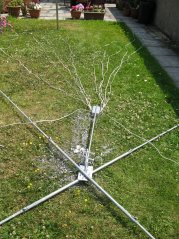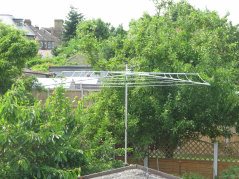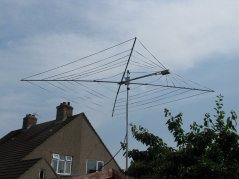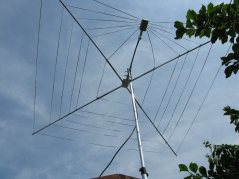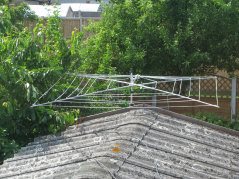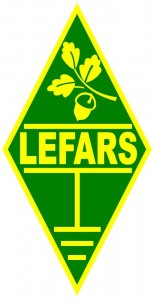Over the years I have experimented with quite a few wire antennas at home increasingly to minimise the effect of the increasing noise level from the likes of plasma TV’s, switch mode power supplies, PLT and ADSL routers but fighting a losing battle on HF.
Some time ago I looked up the Cobwebb type antenna which is supposed to be less susceptable to noise than the various dipoles, doublets etc.
I won’t go into much detail about the Cobwebb as there is a lot of information on the web about it but as it has made claims about lower noise and a smaller footprint I decided that I would take the plunge and make one, to buy one you are looking at £250+ and I thought I could do similiar for about £30. The standard design covers from 20M to 10M i.e. 5 bands although I decided to add a further inner dipole for 6M. There are also comments that builders find it loads up on 30M and 40M possible 60M so I was interested to see if that was true and how efficient it would be.
I downloaded the information on Steve Webb’s G3TPW site (http://www.g3tpw.co.uk/ ) and also looked at several other sites that offered advice on how to build. There are two main design’s depending on whether you use folded dipole elements to match the impedance to 50 ohms or single dipole and a 1 to 4 balun to match 12.5 ohms to 50 ohms, I decided to try the folded dipole version.
If you haven’t seen this antenna before the name immediately gives you a clue what it looks like, just needs a large spider in the middle for completeness ! It also has the advantage of looking like a large rotary clothes line so you can pretend it is not an antenna although not so easy to hang your washing 30 feet in the air.
This is a basic diagram of Cobwebb.
I started to look for materials to build the cobwebb and decided to utilise a 10 inch square of 8mm thick aluminium for the base plate and mount the two spreaders plus central support for dipole feeds using U bolts. For the two spreaders which are approximately 12 feet long, I used a combination of two 4 feet long nylon tubes and two 5 feet long pieces of nylon rod plus a 4 foot nylon rod to support the feed and mast mounting bracket. For the dipoles I used white twin speaker cable and where the two ends of each dipole are joined some CENEX elastic fishing line to allow some give but keep the dipoles in place. The dipoles are held in place on the spreaders via small plastic clips.
Below are some pictures, the more observant will see where I sprayed the grass grey whilst spraying the spreaders so that would try and match the garage roof where I was going to mount the antenna !
Cobwebb on ground before Cobwebb mounted on mast about 15 assembley of dipoles on spreaders in the air ready for testing
Two different views of Cobwebb looking up
Cobwebb in its stowed position hidden amongst trees !
So now it is built how does it perform ? Well by a fair amount of tweaking I can run on 20M to 10M without an ATU and noise wise it is much quieter than the doublet I was running before. I do not hear any ADSL type noise on HF at all which is quite surprising considering with the various combinations of wire antennas it was S9+ outside the notched bands. The antenna is about 60 feet away from any houses so I guess the combination of that plus its supposed lower immunity to noise is working but early days yet.
With an ATU it will load up on 60M, 40M and 30M and I can hear quite a few stations but it is early days yet to really assess what the efficiency is at these bands. I will post more info once I have spent more time operating but I intend to try WSPR on all the bands just to see how it performs.
So importantly the visual effect on the locals etc ! Well so far OK the XYL did make a few comments about it looking like a washing line ! I suggested that with the line at 30 feet it would allow the washing to dry quicker, she could then get down to ironing quicker and hence her domestic efficiency would be increased but you can guess what sort of response I got, any get well cards would be appreciated !
Next step is to look at making a portable version based on the excellent article by G0NQE here http://www.g0nqe.co.uk/projects/porta_web
Richard Clark
G4DDP / G8BXC
Email: g4ddp@lefars.org.uk


